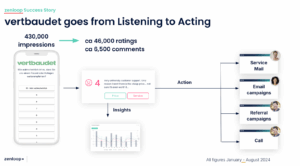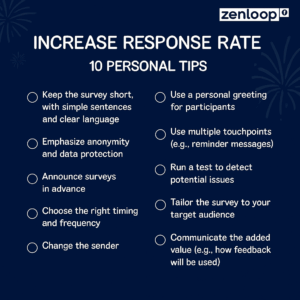What is the Response Rate? Definition, Calculation & 10 Tips to Increase It
A high response rate is essential for collecting meaningful customer feedback. Without sufficient participation, even the best survey questions can lead to skewed or unreliable results.rnrnIn this blog post, we explain what the response rate means, how to calculate it correctly, and why it’s important for customer experience and loyalty. You will also find 10 practical tips to boost your survey’s completion rate and gather more actionable insights from your customers.

Table of Contents
- What does response rate mean?
- How do survey formats influence the response rate?
- Why the Survey Response Rate Matters
- How is the response rate calculated?
- What does the calculation look like using the example of Stadtwerke Kassel?
- Example: vertbaudet response rate
- What are possible reasons for unit non-response and item non-response?
- How to increase your response rate – a checklist with 10 personal tips from us to you!
- Conclusion: A high response rate pays off
What does response rate mean?
The response rate refers to and describes the percentage of people who respond to a survey —that is, who complete it completely or partially. It compares the number of planned and completed surveys.
Companies often conduct quantitative surveys. It’s crucial for them to know how many of the invited respondents not only noticed the survey but actually participated. A company can easily determine this with the help of a feedback tool like zenloop’s.
How do survey formats influence the response rate?
The way a survey is conducted has a significant impact on how many people actually participate. Some formats naturally achieve higher response rates – depending on the target audience and timing. There are different ways companies can conduct surveys:
- Online surveys (e.g. by email, on the website, in the online shop)
- Telephone survey
- Mail surveys Interested in the best ways to share surveys with customers?
Check out zenloop’s blog post on the topic. – the most effective options are shown there.
Why the Survey Response Rate Matters
The survey response rate is a critical metric for companies because it reflects both the relevance of the survey results and the quality of the survey design. A higher response rate generally leads to more reliable insights and ensures that the feedback collected is representative of the target audience.
Benchmarks for B2B vs. B2C Survey Response Rates
Response rate benchmarks vary significantly depending on the business model:
B2B surveys: A typical response rate ranges between 20% and 40%, as business audiences tend to be more engaged and have a vested interest in industry-specific topics.
B2C surveys: These usually achieve lower rates, often between 10% and 20%, due to higher audience diversity and survey fatigue in consumer markets.
Exception cases: In specialized industries like custom-manufactured OEM products, survey response rates can exceed 45%, demonstrating that a well-targeted approach can boost participation significantly.
Why a High Response Rate Improves Customer Experience
If the response rate falls below industry benchmarks, the authenticity and reliability of the survey data are at risk. On the other hand, a high response rate not only strengthens the accuracy of insights but also builds customer loyalty. When businesses acknowledge customer input, act on feedback, and demonstrate transparency, participants feel heard, making them more likely to remain engaged and loyal to the brand.
For practical strategies on how to design effective surveys that drive higher response rates, explore our detailed guide: How to Conduct Customer Surveys Correctly.
How is the response rate calculated?
The response rate can be calculated manually . It’s also quite easy! You can use the following formula:
Response Rate (%) = (Number of responses / Number of survey invitations) × 100
However, the response rate calculation for online surveys conducted using a feedback tool like zenloop can usually be done automatically. Zenloop is a powerful feedback tool that helps companies automatically capture, analyze, and leverage customer opinions.
Compared to manual calculation and evaluation, zenloop offers advantages: Response rates are determined automatically and accurately, customer feedback is intelligently analyzed in real time and clustered thematically, and dissatisfied customers can be directly won back through automated responses. All of this can be seamlessly integrated into existing tools and systems.
The gross response rate includes all respondents who completed the survey, but it doesn’t take into account whether they completed all fields completely. This scenario falls under a special form of non-response rate known as item non-response .
The net response rate is the proportion of respondents who completed the questionnaire completely and without any missing information.

The non-response rate refers to the proportion of invited respondents who did not complete the survey. It is also known as unit non-response. It can be calculated as follows:
Non-response rate = 100- response rate
What does the calculation look like using the example of Stadtwerke Kassel?
Now that we have clarified how a response rate can be calculated, we will now apply this knowledge in practice, using the examples of Stadtwerke Kassel and vertbaudet. We will look at what different response rates indicate and which strategies can help to specifically improve them.
The Stadtwerke Kassel surveys received a total of 700,000 impressions by September 1, 2024. 9,000 of these completed the survey. The response rate can be calculated using the following formula:
Response rate (%) = (Number of reviews received / Number of review requests sent) × 100
Number of reviews received: 9,000
Number of review requests sent: 700,000

Answer: The response rate is approximately 1.29%. Due to the minimum values “>9,000” and “>700,000,” the response rate could be slightly higher.
Why is the response rate comparatively low?
A response rate of around 1.3% is not uncommon in the public sector—especially for large-scale email or online campaigns. Possible reasons for a low response rate may include:
- The invitation to the survey gets lost in the mass of messages (e.g. in emails or pop-ups).
- The survey was poorly displayed on mobile devices or was not technically implemented optimally. • Participation seems unattractive or too time-consuming for many people
There is a lack of clearly communicated added value for users.In many cases, such rates can be significantly increased through targeted optimizations in the approach, timing or design.
Example: vertbaudet response rate
 A successful example of how to successfully deal with Customer feedback provides the Baby clothing brand vertbaudet. Within just eight months, the Companies received over 46,000 survey responses and around 6,500 comments – with more than 430,000 Impressions. With the help of zenloop , this feedback was not only evaluated but also specifically implemented into concrete measures such as service emails, personalized calls , or customer loyalty campaigns. This impressively demonstrates that customer centricity doesn’t end with listening—it begins there.
A successful example of how to successfully deal with Customer feedback provides the Baby clothing brand vertbaudet. Within just eight months, the Companies received over 46,000 survey responses and around 6,500 comments – with more than 430,000 Impressions. With the help of zenloop , this feedback was not only evaluated but also specifically implemented into concrete measures such as service emails, personalized calls , or customer loyalty campaigns. This impressively demonstrates that customer centricity doesn’t end with listening—it begins there.
What are possible reasons for unit non-response and item non-response?
Often, invited respondents don’t even participate in a survey or abandon it prematurely. Individual unanswered questions are also common – and this can have various reasons, such as:
Reasons for unit non-response:
– Refusal to participate – Inviters are unable to participate in the survey (e.g. due to disability)
– Lack of accessibility
Reasons for item non-response:
– sensitive or very personal questions
– Questionnaire too extensive
– Usability of the questionnaire
How to increase your response rate – a checklist with 10 personal tips from us to you!
- Keep the survey short,with simple sentences
and clear language - Emphasize anonymity and data protection
- Announce surveys in advance
- Choose the right timing
and frequency - Change the sender
- Use a personal greeting
for participants - Use multiple touchpoints (e.g., reminder messages)
- Run a test to detect potential issues
- Tailor the survey to your
target audience - Communicate the added
value (e.g., how feedback will be used)
Example: A fashion company conducts a survey among regular customers who regularly shop through the app. The survey is displayed directly in the app, takes only two minutes, and relates to their most recent order.For new customers who discovered the company via social media, the survey is conducted via Instagram Stories with simple, image-based questions and voting options – tailored to the channel and usage situation

Conclusion: A high response rate pays off
In conclusion, it’s worthwhile for companies to work specifically on increasing response rates. Tools like zenloop make it particularly easy for companies to keep track of response rates and gain direct actionable knowledge from them. This turns a number into true customer centricity. After all, the more customers participate in a survey, the more meaningful the results. A high response rate not only strengthens the quality of the insights but also signals appreciation for your customers – their opinion counts! This, in turn, builds trust, promotes customer loyalty, and forms the basis for customer-centric action.
FAQ
What is a good response rate for employee surveys?
Traditional employee surveys usually achieve response rates between 60% and 80%. A participation rate above 70% is considered especially meaningful and should be the goal in order to gain a reliable picture of employee sentiment.
What is the completion rate?
A completion rate is a common synonym for response rate. It indicates how many of the invited individuals actually participated in a survey—that is, the ratio of invitations sent to responses received.
Best tool to increase survey response rate?
u003carticle class=u0022text-token-text-primary w-fullu0022 dir=u0022autou0022 data-testid=u0022conversation-turn-156u0022 data-scroll-anchor=u0022trueu0022u003ernu003cdiv class=u0022text-base my-auto mx-auto pb-10 [u002du002dthread-content-margin:u002du002dspacing(4)] @[37rem]:[u002du002dthread-content-margin:u002du002dspacing(6)] @[72rem]:[u002du002dthread-content-margin:u002du002dspacing(16)] px-(u002du002dthread-content-margin)u0022u003ernu003cdiv class=u0022[u002du002dthread-content-max-width:32rem] @[34rem]:[u002du002dthread-content-max-width:40rem] @[64rem]:[u002du002dthread-content-max-width:48rem] mx-auto flex max-w-(u002du002dthread-content-max-width) flex-1 text-base gap-4 md:gap-5 lg:gap-6 group/turn-messages focus-visible:outline-hiddenu0022u003ernu003cdiv class=u0022group/conversation-turn relative flex w-full min-w-0 flex-col agent-turnu0022u003ernu003cdiv class=u0022relative flex-col gap-1 md:gap-3u0022u003ernu003cdiv class=u0022flex max-w-full flex-col growu0022u003ernu003cdiv class=u0022min-h-8 text-message relative flex w-full flex-col items-end gap-2 text-start break-words whitespace-normal [.text-message+u0026amp;]:mt-5u0022 dir=u0022autou0022 data-message-author-role=u0022assistantu0022 data-message-id=u00221c67a62f-7623-465b-a90d-e79146130ed8u0022 data-message-model-slug=u0022gpt-4ou0022u003ernu003cdiv class=u0022flex w-full flex-col gap-1 empty:hidden first:pt-[3px]u0022u003ernu003cdiv class=u0022markdown prose dark:prose-invert w-full break-words lightu0022u003ernu003cp data-start=u0022787u0022 data-end=u00221196u0022 data-is-last-node=u0022u0022 data-is-only-node=u0022u0022u003eA particularly effective tool for boosting response rates is u003cstrong data-start=u0022848u0022 data-end=u0022859u0022u003ezenloopu003c/strongu003e. The platform offers automated, cross-channel surveys with smart timing, personalized messaging, and seamless integration into existing systems. With features like reminder messages, audience targeting, and real-time analytics, companies can not only increase their response rates—but also significantly enhance the customer experience.u003c/pu003ernrnu003c/divu003ernu003c/divu003ernu003c/divu003ernu003c/divu003ernu003cdiv class=u0022mx-[var(u002du002dmini-thread-content-inset)]u0022u003ernu003cdiv class=u0022flex min-h-[46px] justify-startu0022u003ernu003cdiv class=u0022touch:-me-2 touch:-ms-3.5 -ms-2.5 -me-1 flex flex-wrap items-center gap-y-4 p-1 select-none touch:w-[calc(100%+u002du002dspacing(3.5))] -mt-1 w-[calc(100%+u002du002dspacing(2.5))] duration-[1.5s] focus-within:transition-none hover:transition-none pointer-events-none [mask-image:linear-gradient(to_right,black_33%,transparent_66%)] [mask-size:300%_100%] [mask-position:100%_0%] motion-safe:transition-[mask-position] group-hover/turn-messages:pointer-events-auto group-hover/turn-messages:[mask-position:0_0] group-focus-within/turn-messages:pointer-events-auto group-focus-within/turn-messages:[mask-position:0_0] has-data-[state=open]:pointer-events-auto has-data-[state=open]:[mask-position:0_0]u0022u003eu003c/divu003ernu003c/divu003ernu003c/divu003ernu003cdiv class=u0022mt-3 w-full empty:hiddenu0022u003ernu003cdiv class=u0022text-centeru0022u003eu003c/divu003ernu003c/divu003ernu003c/divu003ernu003cdiv class=u0022aria-live=polite absoluteu0022u003ernu003cdiv class=u0022flex items-center justify-centeru0022u003eu003cspan class=u0022flex items-center gap-1.5 select-noneu0022u003eu003cspan class=u0022sr-only whitespace-nowrap! md:not-sr-onlyu0022u003eChatGPT fragenu003c/spanu003eu003c/spanu003eu003c/divu003ernu003c/divu003ernu003c/divu003ernu003c/divu003ernu003c/divu003ernu003c/articleu003ernu003cdiv class=u0022pointer-events-none h-px w-pxu0022 aria-hidden=u0022trueu0022 data-edge=u0022trueu0022u003eu003c/divu003e





